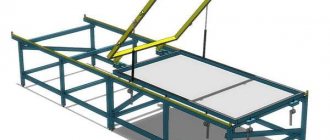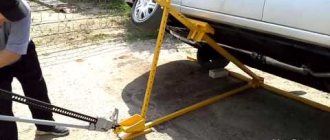Vacuum pump for changing oil from a 3-liter can and a vacuum cleaner
One of the main reasons that drivers do not change the oil on time is the lack of an inspection hole or overpass, however, it is quite possible to do without them.
To quickly change the oil, you can use a homemade design (I found it on the Internet), which is very easy to assemble. And now I’ll tell you how! All you need is a few tubes, a couple of hoses, a 3-liter jar and a vacuum cleaner. From all this you can assemble a home vacuum suction apparatus. Hardware oil changes are now very popular because they take less time than a regular one, and in this case you don’t need to remove the crankcase protection and pour oil on your hands when unscrewing the drain bolt.
Features of hardware oil change
Hardware oil changes are offered at many modern service stations. Not all motorists know about the features of this procedure. It is for this reason that disputes arise about the advantages and disadvantages of hardware oil changes when comparing the technique with traditional technology. Doubts about effectiveness arise from a lack of information. The classic technology of changing engine oil is performed by many motorists at home, so almost everyone knows about this procedure. Hardware technology cannot be performed in a workshop or garage. The peculiarity is that the replacement must be performed in several stages. The work must be performed only using professional equipment.
How to assemble a vacuum oil suction
We cut a hole in the lid in which we place the cut tee and part of the unnecessary attachment from the vacuum cleaner. Fill all the joints between the elements and the lid with hot glue, then with superglue (use glue to strengthen it). After drying, we assemble everything with a PVC pipe. The end result should be a design like this.
If someone is too lazy or doesn’t have time to make such a homemade product, then you can buy ready-made versions of such designs on Aliexpress.
Write in the comments what you think about such devices and this method of changing the oil!
Syringe for pumping oil through the dipstick
In the same way, you can pump out the oil through the dipstick using a syringe, but not a pharmaceutical one (Zhanet). No, they can do it too, but why bother and waste it drop by drop when there are inexpensive, professional and semi-professional solutions.
Such syringes are convenient and suitable for any type of technical fluid used in car components. The replacement procedure is exactly the same as when using an electric or vacuum pump.
Dear readers! If you have proven pumps, other methods of changing oil through a dipstick, suggestions or comments - we will be happy to read them in the comments! Also, we will be very grateful if you share this post with your friends on VKontakte , Odnoklassniki, Facebook, Twitter, and other social networks and Internet platforms.
Source
How to use a homemade product for vacuum oil extraction
Actually, already at this stage it should be clear how this design works. All that remains is to put this homemade product on the can and connect the vacuum cleaner hose. With such a vacuum pump, you can change the oil yourself, without having to look for a hole or go to a service station. Moreover, oil can be pumped out not only from the engine, but also from the gearbox.
Functionality check
First, warm up the engine to operating temperature (so that the oil is thinner, but 70 will be enough). We take out the oil dipstick, insert the PVC tube into the hole as far as it will go, then connect the hose from the vacuum cleaner to our homemade vacuum apparatus, and turn on the vacuum cleaner. The pump will pump out the waste without difficulty.
For me, with 3.5 liters of oil in the engine, the whole procedure took about 5 minutes. The oil is completely pumped out. All that remains is to replace the oil filter and add fresh oil.
Quick oil change: what you need to know
In practice, lubrication plays a primary role, and the quality of the oil, compliance with a particular type of engine, the level and condition of the lubricating fluid largely determines the service life of the power plant, as well as the serviceability of the unit. Oil also significantly affects certain performance indicators and characteristics of the internal combustion engine.
First of all, replacement intervals are determined depending on the base stock of the lubricant used (mineral, semi-synthetic or synthetic). Experienced car enthusiasts additionally make adjustments for the features and individual operating conditions of the engine.
If we talk about replacement methods, recently the service of express engine oil change has been especially in demand. Moreover, some car enthusiasts have also switched to this method privately, purchasing the necessary equipment for personal use. At the same time, the garage may have all the conditions for draining through a pan (inspection hole, a set of keys, rags and a container for draining waste).
Benefits of express oil change
As you can see, vacuum (hardware) replacement is quite attractive. In a nutshell, the oil is sucked out through the dipstick and then accumulates in the reservoir. Naturally, in this case there is no need for a pit or a lift; there is no need to remove the engine protection (if there is one, and also provided there is free access to the oil filter from above).
As a result, first of all, it is possible to save time. This is the main advantage. It is for this reason that for large car services and official dealer service stations such an express replacement (vacuum oil change) is much more profitable than the traditional one, when the oil is drained by gravity through a hole in the oil pan after unscrewing the drain plug.
By the way, if we talk about the concepts of “express oil change”, “vacuum” or “hardware” replacement, it is worth noting that in all cases pumping through the dipstick is assumed. And you can do this:
- Using a hand pump. It turns out not quite “express”, but still noticeably faster than traditional draining. Also, the equipment is simple and accessible to every car enthusiast.
- Pumping out using a vacuum or hardware replacement occurs according to a similar principle, however, instead of a hand pump, it is assumed that there is an electric compressor or a special ready-made installation-apparatus for pumping out oil with reservoirs in which the pumped-out waste is accumulated, a self-cleaning system, etc. On average, it takes 10-15 minutes to change the oil on the device.
Now let's look at the procedure and equipment itself. Let's start with the simplest solutions. As a rule, this is equipment that is capable of creating a vacuum and with the help of which old oil is “pumped out” from the engine. In fact, pumping occurs with the help of a hand pump; the reservoir for extraction does not have a large capacity (usually up to 5-6 liters).
As for professional express replacement systems, they are distinguished by the presence of an electric compressor and a much larger capacity for collecting waste. There are solutions that can hold almost 50 liters. old oil, that is, you can quickly perform up to 10-12 changes.
The devices are also equipped with special adapters, hoses, connections, etc. This allows you to pump oil out of the crankcase as efficiently as possible, taking into account the characteristics of a particular engine.
- To change the lubricant using the indicated methods (hardware or using a hand pump), at the very beginning the engine is warmed up to operating temperature. Warming up is necessary to dilute the lubricating fluid, which flows into the oil pan and is easily pumped out by a device or using a hand pump.
- Next, you need to remove the dipstick to check the oil level, and insert a thin tube into the neck of the dipstick. The tube is inserted as deeply as possible, then the free end is connected to a container in which a vacuum is created. The pressure difference allows you to “pull” the lubricant out of the engine through the tube.
- At the end of the procedure, the tube is removed from the dipstick neck, then the oil filter must be changed. Next, fresh oil is poured through the oil filler neck, the level is controlled by the dipstick.
As you can see, changing the oil is quick, pumping is effective, there is no need to drive the car into a pit or onto a lift, or unscrew the drain plug (especially if the said plug has a broken thread).
We also recommend reading the article on how to change the engine oil yourself. From this article you will learn how to change the oil in an internal combustion engine, as well as various features and nuances that need to be taken into account as part of this procedure.
Also, as already mentioned, if there is engine protection, such protection does not need to be removed on many cars. If you have access, you can replace the oil filter from above, without even going under the car.
Disadvantages of vacuum engine oil change
At first glance, it may seem that the method described above has only continuous advantages. However, in practice this is not entirely true.
- First of all, do not forget that there is always a risk of breaking the tube that is inserted into the neck of the dipstick. In this case, problems will arise associated with removing such a fragment, since the oil pan must be removed.
- Also, many experts claim that pumping out the oil allows you to drain it in a smaller volume compared to traditional draining.
- You can also often hear from opponents of express replacement that with this method it is not possible to simultaneously check the suspension, the condition of the car body from below, brake pads, etc.
However, in practice, as a rule, it is the second reason that makes experienced car enthusiasts rather skeptical about this replacement method. The fact is that large quantities of old oil residues can significantly affect the service life and properties of fresh lubricating fluid, since mixing inevitably occurs.
Moreover, if a transition is made from one oil to another, before changing the oil, additional flushing of the lubrication system, etc. was performed, in this case, not only the old waste, but also the remains of the flushing fluid will be mixed with a fresh portion of engine oil. The result is a strong influence of the mixture of working out and flushing on the recently filled in fresh lubricant.
It is also noteworthy that even the use of powerful, expensive devices with a whole set of probes and adapters for replacement, as well as pre-chambers to control the volume of pumped out oil, does not change the situation much. In other words, traditional draining of lubricant through a plug will still be more effective compared to pumping out using vacuum systems.
This means that it is best to remove clots, dirt particles, metal shavings and other fractions that settle at the lower points of the pan only through a classic drain.
Why change the oil in your car engine?
A car engine is a complex structure, the operating principle of which is based on the rotation of various parts. This creates friction, which oil is designed to minimize. It also removes heat from engine parts and protects them from corrosion. Timely replacement is necessary to extend the life of the motor.
It is recommended to change the oil fluid every 10 thousand kilometers , unless a different period is specified by the manufacturer.
Changing the oil on time reduces engine wear, namely:
- reduces friction of engine parts;
- prevents engine overheating;
- reduces the formation of corrosion.
Methods for changing engine oil
Traditionally, the oil liquid is drained through a hole, but there is also an express method of pumping out the waste using a pump. The second method is much simpler due to the absence of the need to lift the car and remove the protection from the engine.
Replacement by draining through a hole
With this method, the waste is drained through a hole located in the engine sump. It is closed with a plug, which requires a special key to unscrew.
During this procedure, it is also necessary to replace the drain plug gasket.
Replacement by pumping out using a pump
This method involves pumping out the waste fluid without unscrewing the oil plug. The oil pump can be manual, mechanical, or electric based on a small motor. You can buy it in a store or make it yourself.
Changing oil using a pump: advantages and disadvantages
This method of replacing used fluid has both advantages and disadvantages.
The advantages include the following:
- no special key is needed for the drain plug;
- no need to lift the car on a lift;
- the process of pumping out oil takes much less time than draining it.
Disadvantages of the pumping method:
- low wear resistance of the tube with insufficient skill there is a possibility of accidentally breaking it;
- there is a risk of not completely pumping out the waste, and sediment may remain.
Types of oil pumps
Currently, you can find a huge number of types of pumps on sale that allow you to pump oil out of a car engine. We list their main types:
- Manual mechanical or vacuum pump.
- Pneumatic pump.
- Electric pump of various designs. Can operate on 220V or 12V voltage.
Among the manual ones, barrel pumps are popular: siphon, rotary and lever pumps for diesel fuel and kerosene. They are used to pump oil from a barrel.
Electric pumps are divided into the following modifications:
- gate plate;
- plunger;
- diaphragmatic.
These models are also suitable for pumping diesel fuel or waste oil liquid.
Pumping oil through the dipstick with an electric pump
You can spend a little money, but get a ready-to-use device. Again, there are a lot of options. Our favorite can be found on Aliexpress, the eternal rotary pump for pumping oil through a dipstick, which has a huge resource and is very easy to use.
The pump body is made of aluminum (it is quite heavy), there are two fittings on it for the intake and discharge of liquid - they are equipped with universal quick releases, that is, no mating connectors are needed, just insert the tube and the connection is ready!
Another important advantage is the jumper on the housing through which the pump power cable is routed. It is made in such a way that even if the pump falls, the wire will not be damaged.
The pump is powered by the same 12V using crocodiles, but already produces 0.3 MPa of pressure (this is almost 3 atmospheres, which is 3 times more than the washer pump). The kit includes 2 tubes of 3 meters each. In general, nothing else is needed - turn it on and off.
The price of such a pump is not small, but believe me, it is worth it.
View and buy
You can consider a cheaper option, but we personally cannot recommend it to you, since we have not used it. Also, if the first pump can pump out not only oil, but also fuel, oil from the automatic transmission, then this will not work, and its performance is less. And yes, you can buy it not only on Ali, but there it will cost much more.
We make a pump for changing the oil with our own hands
It is also possible to make an oil pump with your own hands. In this case, it is possible to get by with a simple design based on a medical syringe, or make a more complex design using an electric motor.
Medical syringe pump
This device is a mechanical hand pump for oil. A syringe pump is ideal for extracting small volumes of liquids. Use this design to pump oil out of a car engine.
Materials and tools
To make a pump for changing oil through a dipstick, you will need the following materials:
- medical syringe 20 ml or more. You can try to get by with a smaller volume, but the process of pumping liquid will be quite long.
- an IV from a pharmacy, only a tube will be useful for it. If desired, use a similar tube or hose that matches the diameter of the syringe.
- An empty bottle or other container to collect used oil.
Sequence of work
- Cut off all excess from the dropper with scissors so that only the rubber tube remains.
- Place the tube onto the cone of the syringe.
- After opening the hood, remove the oil dipstick from the car engine.
- Slowly pull back the piston until it is completely filled with waste.
- Now you need to disconnect the syringe and drain the used oil into a container. You can completely remove the tube from the engine and place it in a container to drain the liquid.
- Repeat the procedure as many times as necessary.
It is not always possible for a car enthusiast to lift the car on a lift. And it is necessary to replace the oil fluid in a timely manner. If it is impossible to lift the car, or if you do not want to get dirty, the ideal option would be a vacuum pump for pumping out oil, made by yourself. Change the oil in your car engine on time, and it will serve you for a long time.
The video shows another pump option.
Source
Replacing and pumping oil through the dipstick - methods, pumps
Changing the oil in a car engine is perhaps a routine task, but it is a necessary procedure if you want it to have a long service life. And everything would be fine, but there is a very dirty and labor-intensive process - draining the oil. We invite you to familiarize yourself with its clean and simple, even more effective alternative - pumping oil through the engine dipstick.
Why is draining oil a labor-intensive process? Because the drain plug is located on the engine sump, which is often hidden behind the engine protection, and to remove it you need to at least find a hole or overpass. We also add to this the fact that a situation may arise when the crankcase plug cannot be unscrewed (it was pulled during the last replacement, it became stuck, etc.). Even after unscrewing it, you do not become the king of the situation, because everything will be spoiled by a stream of hot oil, which sometimes even experienced car enthusiasts cannot catch, and spray oil on everything in the area.
Pump:
The pump is connected using crocodiles (wire length 30 cm):
The kit includes: Copper tube 70 cm (why?);
Silicone hose 120 cm (for drainage); Solid tube 80 cm. Diameter of hoses and copper tube:
Checking the compliance of the characteristics: Measured the current consumption at idle:
Then under load:
Next, I checked how long it would take for the pump to pump 1.75 liters:
The pump pumped approximately 1.75 liters in 30 seconds, which turns out to be 3.5 liters in one minute, which is 1.5 liters less than stated. Initially, the result was even worse, since the tube was of a smaller diameter.











